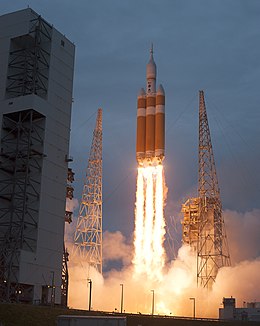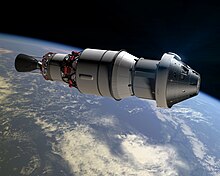Exploration Flight Test-1
 Launch of EFT-1 on 5 December 2014 | |
| Names | Orion Flight Test-1 (OFT-1) |
|---|---|
| Mission type | Technology demonstration |
| Operator | NASA |
| COSPAR ID | 2014-077A |
| SATCAT no. | 40329 |
| Mission duration | 4 hours, 24 minutes |
| Orbits completed | 2 |
| Spacecraft properties | |
| Spacecraft | Orion CM-001 |
| Spacecraft type | Orion |
| Manufacturer | Lockheed Martin |
| Start of mission | |
| Launch date | 5 December 2014, 12:05 UTC (7:05 am EST)[1][2] |
| Rocket | Delta IV Heavy |
| Launch site | Cape Canaveral, SLC-37B |
| Contractor | United Launch Alliance |
| End of mission | |
| Recovered by | USS Anchorage |
| Landing date | 5 December 2014, 16:29 UTC (8:29 am PST) |
| Landing site | Pacific Ocean, 640 mi (1,030 km) SSE of San Diego (23°37′N 114°28′W / 23.61°N 114.46°W) |
| Orbital parameters | |
| Reference system | Geocentric |
| Apogee altitude | 5,800 km (3,604 mi) |
 | |
Exploration Flight Test-1 or EFT-1 (previously known as Orion Flight Test 1 or OFT-1) was a technology demonstration mission and the first flight test of the crew module portion of the Orion spacecraft. Without a crew, it was launched on 5 December 2014 at 12:05 UTC (7:05 am EST, local time at the launch site) by a Delta IV Heavy rocket from Space Launch Complex 37B at the Cape Canaveral Air Force Station.[3]
The mission was a four-hour, two-orbit test of the Orion crew module featuring a high apogee on the second orbit and concluding with a high-energy reentry at around 8.9 kilometers per second (20,000 mph).[4] This mission design corresponds to the Apollo 2/3 missions of 1966, which validated the Apollo flight control system and heat shield at re-entry conditions planned for the return from lunar missions.
Objectives
[edit]EFT-1 tested various systems of the crew module portion of the Orion spacecraft, including separation events, avionics, heat shielding, parachutes, and recovery operations prior to its flight aboard the Space Launch System rocket on the Artemis I mission. The Orion was not equipped with its companion European Service Module, using only a structural representation, and only had a partial launch abort system containing only the jettison motor. It was equipped with an Orion-to-stage adapter for testing.[5]
The spacecraft remained attached to the dummy service module, which in turn remained attached to the Delta IV's upper stage (which is nearly identical to the Interim Cryogenic Upper Stage to be used on the Block 1 version of the Space Launch System rocket) until re-entry began and relied on internal batteries for power rather than photovoltaic arrays.[6]
Data gathered from the test flight were analyzed by the critical design review (CDR) in April 2015.[7] Artemis I launched on 16 November 2022,[8] more than seven years after EFT-1.
Vehicle assembly
[edit]Orion CM-001 used on the EFT-1 mission was built by Lockheed Martin.[9] On 22 June 2012, the final welds of the EFT-1 Orion were completed at the Michoud Assembly Facility in New Orleans, Louisiana.[9] It was then transported to Kennedy Space Center's Operations and Checkout Building, where the remainder of the spacecraft was completed.[10] The Delta IV rocket was put in a vertical position on 1 October 2014, and Orion was mated with the vehicle on 11 November.[11][12][13]
Flight
[edit]



The four-and-a-half-hour flight took the Orion spacecraft on two orbits of Earth. Peak altitude was approximately 5,800 kilometres (3,600 mi). The high altitude allowed the spacecraft to reach reentry speeds of up to 8.9 km/s (20,000 mph), which exposed the heat shield to temperatures up to around 2,200 °C (4,000 °F).[4][5]
| Time | Event |
|---|---|
| L-6:00:00 | Orion powered on, mobile service tower retracts. Fueling of Delta IV Heavy begins |
| 0:00:00 | Launch window opens (7:05 a.m. EST, 12:05 UTC). EFT-1 launches. |
| 0:01:23 | Max Q |
| 0:01:23 | Reach Mach 1 |
| 0:03:56 | Booster separation |
| 0:05:30 | First stage MECO (main engine cut-off) |
| 0:05:33 | First stage separation |
| 0:05:49 | Second stage ignition No. 1 |
| 0:06:15 | Structural representation of service module fairing jettison |
| 0:06:20 | Launch Abort System jettison |
| 0:17:39 | SECO No. 1 (second engine cut-off), Orion begins first orbit |
| 1:55:26 | Orion completes first orbit, second stage ignition No. 2 |
| 2:00:09 | SECO No. 2 (second engine cut-off) |
| 2:05:00 | Enter first high radiation period |
| 2:20:00 | Leave first high radiation period |
| 2:40:00 | Reaction control system (RCS) activation |
| 3:05:00 | Reach peak altitude (5,800 kilometers/3,600 miles) |
| 3:23:41 | Orion separates from service module and second stage, second stage performs disposal burn |
| 3:57:00 | Orion positions for reentry |
| 4:13:41 | Entry interface |
| 4:20:22 | Forward bay cover jettisons, parachute deployment begins (two drogues, three mains) |
| 4:24:46 | Splashdown and recovery by the USS Anchorage crew |
After splashdown in the Pacific Ocean, crews from the USS Anchorage recovered the EFT-1 Orion crew vehicle. Plans were later made to outfit the capsule for an ascent abort test in 2017.[15]
Launch attempts
[edit]| Attempt | Planned | Result | Turnaround | Reason | Decision point | Weather go (%) | Notes |
|---|---|---|---|---|---|---|---|
| 1 | 4 Dec 2014, 7:05:00 am | Hold | — | Fouled Range | A boat entered the launch range. | ||
| 2 | 4 Dec 2014, 7:17:00 am | Hold | 0 days 0 hours 12 minutes | Weather | Wind gusts in excess of speed limit (21 kn or 24 mph or 39 km/h). | ||
| 3 | 4 Dec 2014, 7:55:00 am | Hold | 0 days 0 hours 38 minutes | Weather | Wind gusts in excess of speed limit (21 kn or 24 mph or 39 km/h). | ||
| 4 | 4 Dec 2014, 8:26:00 am | Hold | 0 days 0 hours 31 minutes | Technical | (T−00:03:09) | A fuel fill and drain valve did not close. | |
| 5 | 4 Dec 2014, 9:44:00 am | Scrubbed | 0 days 1 hour 18 minutes | Technical | 24-hour recycle. | ||
| 6 | 5 Dec 2014, 7:05:00 am | Success | 0 days 21 hours 21 minutes |
Public outreach
[edit]NASA heavily promoted the mission, collaborating with Sesame Street and its characters to educate children about the flight test and the Orion spacecraft.[16]
The Orion capsule used for EFT-1 is now on display at the Kennedy Space Center Visitor Complex, in the "NASA Now" exhibit.[17]
Gallery
[edit]- First weld on the EFT-1 Orion structure, September 2011
- Orion structure after final weld, June 2012, at the Michoud Assembly Facility
- Orion's Service Module prior to encapsulation, December 2013, in the Operations and Checkout Building (O&C)
- EFT-1 Orion Weight and Center of Gravity Test, June 2014
- EFT-1 Orion back shell tile installation, September 2014
- Completed EFT-1 Orion, September 2014
- EFT-1 Orion in fairing and with LES, October 2014
- EFT-1 Orion on its Delta IV Heavy, November 2014
- The EFT-1 Orion before splashdown, 5 December 2014
- Recovery of the EFT-1 Orion by the USS Anchorage, 5 December 2014
- Recovery of Orion capsule
- Recovery of Orion capsule
References
[edit]- ^ Rhian, Jason (14 March 2014). "NASA's EFT-1 Mission Slips to December". SpaceFlight Insider. Archived from the original on 13 May 2016. Retrieved 7 December 2014.
- ^ Siceloff, Steven (5 December 2014). "LIFTOFF! Orion Begins New Era in Space Exploration!". Orion. NASA. Retrieved 7 December 2014.
- ^ Foust, Jeff (5 December 2014). "Delta 4 Heavy Launches Orion on Second Attempt". SpaceNews. Retrieved 24 February 2023.
- ^ a b Bergin, Chris (14 November 2011). "EFT-1 Orion Receives Hatch Door—Denver Orion Ready for Modal Testing". NASASpaceflight.com. Retrieved 16 November 2011.
- ^ a b "Orion First Flight Test – NASA Facts" (PDF). NASA. Retrieved 10 October 2014.
- ^ "OFT-1: NASA gearing up for Orion's 2013 debut via Delta IV Heavy". 8 August 2011. Archived from the original on 15 June 2013. Retrieved 16 November 2011.
- ^ "EFT-1 September, 2014 launch date "paced" by the Delta IV-H". nasaspaceflight.com. 7 November 2012.
- ^ "NASA: Artemis I". NASA. Retrieved 2 September 2022.
- ^ a b Clark, Stephen (26 June 2012). "Space-bound Orion capsule to arrive in Florida next week". SpaceFlightNow. Retrieved 28 June 2012.
- ^ "NASA Unveils Orion During Ceremony". NASA. 2 July 2012. Retrieved 3 July 2012.
- ^ "NASA’s Orion Spacecraft, Rocket Move Closer to First Flight" NASA. Retrieved: 5 October 2014.
- ^ "Orion Spacecraft Complete" Archived 31 October 2014 at the Wayback Machine NASA. Retrieved: 30 October 2014.
- ^ "Orion Arrives at Launch Pad" Archived 12 November 2020 at the Wayback Machine NASA. Retrieved: 12 November 2014.
- ^ NASA. "Orion Exploration Flight Test-1" (PDF). Retrieved 15 December 2014.
- ^ Stephen Clark (23 November 2011). "Cracks discovered in Orion capsule's pressure shell". Spaceflightnow.com. Retrieved 23 November 2011.
- ^ NASA (24 November 2014). "Sesame Street Characters 'On Board' as NASA Counts Down to Orion's Test Flight". NASA.gov. Retrieved 6 December 2014.
- ^ "Orion EFT-1 flown spacecraft joins display in 'NASA Now' exhibit | collectSPACE". collectSPACE.com. Retrieved 21 September 2020.


 French
French Deutsch
Deutsch











